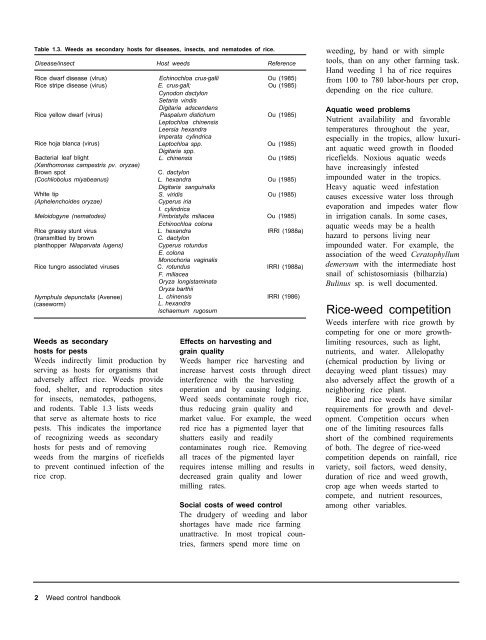A handbbok on Weed Control in Rice.pdf
A handbbok on Weed Control in Rice.pdf
A handbbok on Weed Control in Rice.pdf
Create successful ePaper yourself
Turn your PDF publications into a flip-book with our unique Google optimized e-Paper software.
Table 1.3. <strong>Weed</strong>s as sec<strong>on</strong>dary hosts for diseases, <strong>in</strong>sects, and nematodes of rice.<br />
Disease/<strong>in</strong>sect Host weeds Reference<br />
<strong>Rice</strong> dwarf disease (vlrus) Ech<strong>in</strong>ochloa crus-galli Ou (1985)<br />
<strong>Rice</strong> stripe disease (virus) E. crus-gall;<br />
Cynod<strong>on</strong> dactyl<strong>on</strong><br />
Setaria v<strong>in</strong>dis<br />
Digitaria adscendens<br />
Ou (1985)<br />
<strong>Rice</strong> yellow dwarf (virus) Paspalum distichum<br />
Leptochloa ch<strong>in</strong>ensis<br />
Leersia hexandra<br />
lmperata cyl<strong>in</strong>drica<br />
Ou (1985)<br />
<strong>Rice</strong> hoja blanca (virus)<br />
Leptochloa spp.<br />
Digitaria spp.<br />
Ou (1985)<br />
Bacterial leaf blight<br />
(Xanthom<strong>on</strong>as campestris pv. oryzae)<br />
L. ch<strong>in</strong>ensis Ou (1985)<br />
Brown spot C. dactyl<strong>on</strong><br />
(Cochliobolus miyabeanus) L. hexandra<br />
Digitaria sangu<strong>in</strong>alis<br />
Ou (1985)<br />
Whlte tip<br />
S. viridis Ou (1985)<br />
(Aphelenchoides oryzae) Cyperus iria<br />
I. cyl<strong>in</strong>drica<br />
Meloidogyne (nematodes) Fimbristylis miliacea<br />
Ech<strong>in</strong>ochloa col<strong>on</strong>a<br />
Ou (1985)<br />
Rlce grassy stunt virus L. hexandra IRRI (1988a)<br />
(transmltted by brown C. dactyl<strong>on</strong><br />
planthopper Nilaparvata lugens) Cyperus rotundus<br />
E. col<strong>on</strong>a<br />
M<strong>on</strong>ochoria vag<strong>in</strong>alis<br />
<strong>Rice</strong> tungro assoclated viruses C. rotundus<br />
F. miliacea<br />
Oryza l<strong>on</strong>gistam<strong>in</strong>ata<br />
Oryza barthii<br />
IRRI (1988a)<br />
Nymphula depunctalis (Avenee) L. ch<strong>in</strong>ensis IRRI (1986)<br />
(caseworm)<br />
L. hexandra<br />
lschaemum rugosum<br />
<strong>Weed</strong>s as sec<strong>on</strong>dary<br />
hosts for pests<br />
<strong>Weed</strong>s <strong>in</strong>directly limit producti<strong>on</strong> by<br />
serv<strong>in</strong>g as hosts for organisms that<br />
adversely affect rice. <strong>Weed</strong>s provide<br />
food, shelter, and reproducti<strong>on</strong> sites<br />
for <strong>in</strong>sects, nematodes, pathogens,<br />
and rodents. Table 1.3 lists weeds<br />
that serve as alternate hosts to rice<br />
pests. This <strong>in</strong>dicates the importance<br />
of recogniz<strong>in</strong>g weeds as sec<strong>on</strong>dary<br />
hosts for pests and of remov<strong>in</strong>g<br />
weeds from the marg<strong>in</strong>s of ricefields<br />
to prevent c<strong>on</strong>t<strong>in</strong>ued <strong>in</strong>fecti<strong>on</strong> of the<br />
rice crop.<br />
2 <strong>Weed</strong> c<strong>on</strong>trol handbook<br />
Effects <strong>on</strong> harvest<strong>in</strong>g and<br />
gra<strong>in</strong> quality<br />
<strong>Weed</strong>s hamper rice harvest<strong>in</strong>g and<br />
<strong>in</strong>crease harvest costs through direct<br />
<strong>in</strong>terference with the harvest<strong>in</strong>g<br />
operati<strong>on</strong> and by caus<strong>in</strong>g lodg<strong>in</strong>g.<br />
<strong>Weed</strong> seeds c<strong>on</strong>tam<strong>in</strong>ate rough rice,<br />
thus reduc<strong>in</strong>g gra<strong>in</strong> quality and<br />
market value. For example, the weed<br />
red rice has a pigmented layer that<br />
shatters easily and readily<br />
c<strong>on</strong>tam<strong>in</strong>ates rough rice. Remov<strong>in</strong>g<br />
all traces of the pigmented layer<br />
requires <strong>in</strong>tense mill<strong>in</strong>g and results <strong>in</strong><br />
decreased gra<strong>in</strong> quality and lower<br />
mill<strong>in</strong>g rates.<br />
Social costs of weed c<strong>on</strong>trol<br />
The drudgery of weed<strong>in</strong>g and labor<br />
shortages have made rice farm<strong>in</strong>g<br />
unattractive. In most tropical coun-<br />
tries, farmers spend more time <strong>on</strong><br />
~~<br />
weed<strong>in</strong>g, by hand or with simple<br />
tools, than <strong>on</strong> any other farm<strong>in</strong>g task.<br />
Hand weed<strong>in</strong>g 1 ha of rice requires<br />
from 100 to 780 labor-hours per crop,<br />
depend<strong>in</strong>g <strong>on</strong> the rice culture.<br />
Aquatic weed problems<br />
Nutrient availability and favorable<br />
temperatures throughout the year,<br />
especially <strong>in</strong> the tropics, allow luxuri-<br />
ant aquatic weed growth <strong>in</strong> flooded<br />
ricefields. Noxious aquatic weeds<br />
have <strong>in</strong>creas<strong>in</strong>gly <strong>in</strong>fested<br />
impounded water <strong>in</strong> the tropics.<br />
Heavy aquatic weed <strong>in</strong>festati<strong>on</strong><br />
causes excessive water loss through<br />
evaporati<strong>on</strong> and impedes water flow<br />
<strong>in</strong> irrigati<strong>on</strong> canals. In some cases,<br />
aquatic weeds may be a health<br />
hazard to pers<strong>on</strong>s liv<strong>in</strong>g near<br />
impounded water. For example, the<br />
associati<strong>on</strong> of the weed Ceratophyllum<br />
demersum with the <strong>in</strong>termediate host<br />
snail of schistosomiasis (bilharzia)<br />
Bul<strong>in</strong>us sp. is well documented.<br />
<strong>Rice</strong>-weed competiti<strong>on</strong><br />
<strong>Weed</strong>s <strong>in</strong>terfere with rice growth by<br />
compet<strong>in</strong>g for <strong>on</strong>e or more growth-<br />
limit<strong>in</strong>g resources, such as light,<br />
nutrients, and water. Allelopathy<br />
(chemical producti<strong>on</strong> by liv<strong>in</strong>g or<br />
decay<strong>in</strong>g weed plant tissues) may<br />
also adversely affect the growth of a<br />
neighbor<strong>in</strong>g rice plant.<br />
<strong>Rice</strong> and rice weeds have similar<br />
requirements for growth and devel-<br />
opment. Competiti<strong>on</strong> occurs when<br />
<strong>on</strong>e of the limit<strong>in</strong>g resources falls<br />
short of the comb<strong>in</strong>ed requirements<br />
of both. The degree of rice-weed<br />
competiti<strong>on</strong> depends <strong>on</strong> ra<strong>in</strong>fall, rice<br />
variety, soil factors, weed density,<br />
durati<strong>on</strong> of rice and weed growth,<br />
crop age when weeds started to<br />
compete, and nutrient resources,<br />
am<strong>on</strong>g other variables.











